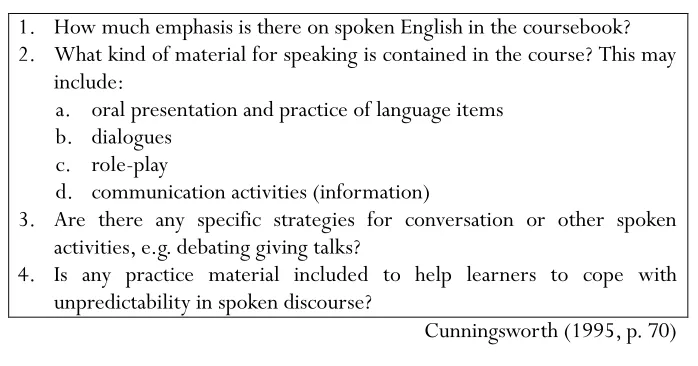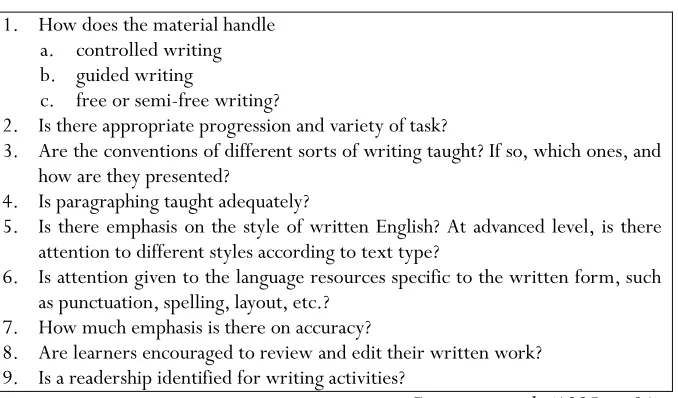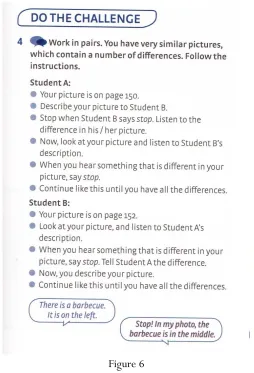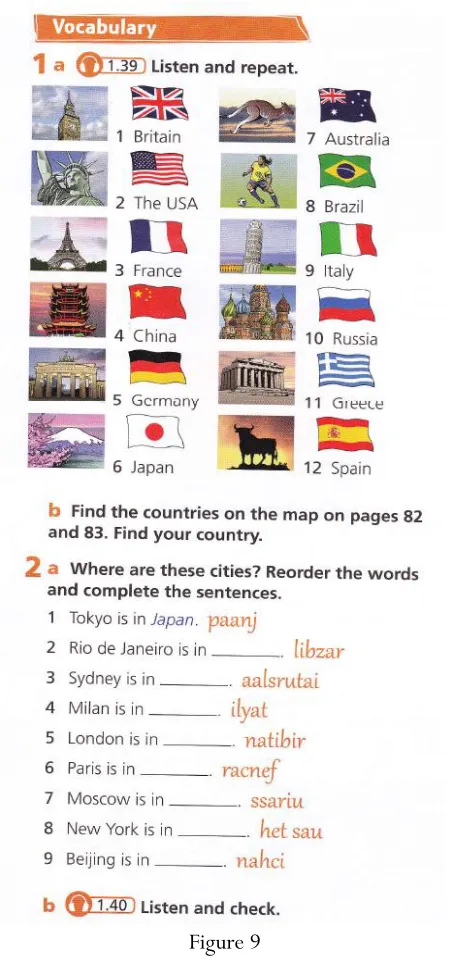WRITING SKILLS IN
PROJECT LEVEL 1
using the theoretical framework as proposed by Cunningsworth (1995). 4 criteria were used to evaluate the presentation of the speaking skill and 9 criteria were used to examine the writing sections. The findings of this study show some interesting similarities and differences that both textbooks have on the presentation of speaking and writing skills.Keywords: textbook evaluation, speaking, writing
INTRODUCTION
IJET | Volume 6, Issue 1. July 2017 27 (Cunningsworth, 1995, p. 14). The most important thing is that the textbook evaluation must be done regularly and continuously.
In this present study, we would like to analyze 2 English textbooks which were published in 2013 and 2015: Project level 1 (4th edition) and Achievers A1+. The target audience for these 2 textbooks is those who are in their beginner level. To our knowledge, these textbooks are widely used in many private schools and language courses in Surabaya, the second biggest city in Indonesia where we are currently staying in. This is also confirmed by 2 staff of reputable bookstores Mentari and Fenros(N.N., a staff of Mentari bookstore, personal communication, March 19, 2016 and NN a staff of Fenross bookstore, personal communication, March 24, 2016).
Our present study focused on the evaluation of speaking and writing skills published in Project level 1 (4th edition) and Achievers A1+. We focused on these 2 skills because both speaking and writing skills as are important parts of communication. In that sense, textbooks are needed to help both teachers and students develop their speaking and writing skills to be able to communicate effectively and efficiently in written and spoken language. To evaluate the skills, we used the following criteria:
Table 1.Checklist for Evaluating Speaking Skill
1. How much emphasis is there on spoken English in the coursebook? 2. What kind of material for speaking is contained in the course? This may
include:
28 IJET | Volume 6, Issue 1. July 2017
2. Is there appropriate progression and variety of task?
3. Are the conventions of different sorts of writing taught? If so, which ones, and how are they presented?
4. Is paragraphing taught adequately?
5. Is there emphasis on the style of written English? At advanced level, is there attention to different styles according to text type?
6. Is attention given to the language resources specific to the written form, such as punctuation, spelling, layout, etc.?
7. How much emphasis is there on accuracy?
8. Are learners encouraged to review and edit their written work? 9. Is a readership identified for writing activities?
Cunningsworth (1995, p. 84)
METHOD
The data for this study was taken from two different English textbooks entitled Project level 1 (4th edition) and Achievers A1+. Project level 1 (4th edition) was published by Oxford University Press in 2013; and it has6 chapters: Introduction, Friends and family, My world, Time, Places, and People (Hutchinson, 2013). Achievers A1+ was published by Richmond in 2015, andthere are 9 units available: Free time, School is cool!, Party time!, Wonderful
world, Let’s go out, Long ago, Wild world, Getting away, and Digital world(Barraclough et al., 2015).We focused on the skill sections for speaking and writing that are provided in these two different English textbooks. We referred to Cunningsworth‟s checklist (1995) as we evaluated the skill sections. Any identified interesting features or points along with the examples were then noted down.
FINDINGS AND DISCUSSION
IJET | Volume 6, Issue 1. July 2017 29 textbooks.
SPEAKING
Project Level 1 (4th edition)
Project Level 1 (4th edition) textbook seems to focus more on speaking skill compared to other skills (i.e. listening, speaking, reading and writing). It can be proven by seeing the number of the exercises given for speaking. Seeing from the Table of Content of the book on page 2 that there are 21 exercises in total for speaking, while for listening there are 15 exercises, for writing 10 exercises, and for reading 7 exercises.
Moreover, the practice materials for speaking can be found easily in
other skills‟ exercises or in other sections such as, comprehension and
grammar. For example, the listening exercise on page 23 (exercise 6) presented below is integrated with speaking.
Figure 1
30 IJET | Volume 6, Issue 1. July 2017
At first, in exercise 6a, the learners are asked to listen to the dialogues to answer some questions provided. After they fill in the answers, in exercise 6b, the learners are asked to act the dialogues in pairs by using the chart that they have answered.
The materials to practice speaking skill in this textbook includes dialogue, communication activities (information gap), and other kinds of activities including, asking and answering, describing, interviewing, playing games and acting out stories. All kinds of materials mentioned above, except for interviewing, are found in speaking sections, while in other sections, wefound dialogue and interviewing.
Project Level 1 (4th edition) also introduces specific strategies for conversation and other spoken activities to the learners. The specific strategies in this textbook refer to some vocabularies and useful expressions which can help the learners to speak using different kinds of expressions in different situations. The textbook also present some exercises that should be used to practice using the vocabularies and useful phrases discussed.
Figure 2
IJET | Volume 6, Issue 1. July 2017 31 Figure 2 shows an example in Exercise 5 on page 7. This section presents vocabularies and phrases that can be used in giving instructions or directions. Another example is Exercise 8 on page 7. This exercise gives an opportunity for the learners to practice using the vocabularies and phrases to gives instructions to other people.
Other than specific strategies, there are also some practice materials found in the textbook to help the learners cope with unpredictability in spoken discourse. The practice materials given in the textbook are in a form of having conversations, interviewing, giving instructions, and also playing games.
Figure 3
Source: Project Level 1 (4th edition), 2013, p. 31
32 IJET | Volume 6, Issue 1. July 2017
Exercise 5a on page 31 shown above is an example of the practice material. The learners should predict what their partner will say about the picture. This kind of material includes element of uncertainty and unpredictability where the learners cannot predict what their speaking partners will say. Thus, by having kinds of exercises in a form of having conversations, interviewing, giving instructions, and also playing games, the learners can practice their speaking skill in unpredictable situations.
Achievers A1+
Achievers A1+ textbook also pays attention to the speaking skill. Each unit provides section for speaking; and there are various kinds of speaking activities provided. Moreover, speaking is integrated with other skills mostly listening and reading.
Figure 4
IJET | Volume 6, Issue 1. July 2017 33 In the listening section on page 63, for example, there are speaking exercises (exercise 1 and 6) in which the learners are asked to discuss some questions and exchange some information with their partners.
The speaking materials provided in this textbook are in the form of dialogue, role-play, communication activities (information gap), discussions in pairs or groups, oral presentation, describing, telling stories, and interviewing. The types of materials that the writer found in speaking sections are in the form of dialogue, role-plays, and discussions. Meanwhile, the types of materials that the writer found in other sections (such as in reading and listening sections) are communication activities (information gap), oral presentations, discussions, interviewing, describing, and storytelling.
Achievers A1+ textbook offers specific strategies for conversation and other spoken activities in a form of useful phrases that can be used to teach strategies and skills of speaking. These useful phrases can be found in each speaking skill section, particularly in one sub-section named „Express yourself‟. The sub-section provides some useful phrases or expressions that can be used in real unpredictable situations.‘Express yourself’ ‟sections can be found on pp. 16, 26, 36, 48, 58, 68, 86, 90, and 100. One of the examples of
‘Express yourself’ ‟section is shown below.
There are many speaking activities provided in this book.On p. 100 (exercise 6), there is an activity in which the learners must make requests
using some useful phrases provided on „Express yourself’section.By having this
34 IJET | Volume 6, Issue 1. July 2017 Figure 5
Source: Achievers A1+, 2015, p. 100
IJET | Volume 6, Issue 1. July 2017 35 genuine conversations or discussions. Through such exercises, the learners can practice their speaking skill in unpredictable situations.Exercise 4 on page 35 will be shown below as an example of the practice material.
Figure 6
Source: Achievers A1+, 2015, p. 35
Similarities and Differences
36 IJET | Volume 6, Issue 1. July 2017
speaking activities not only in speaking sections but also in different skill areas, too.
Both textbooks include dialogues and communication activities for speaking material and provide activities that the learners can use to practice. However, Project level 1 (4th edition) textbook does not provide role-play as one of the speaking materials or any other material that can encourage the learners to practice speaking in front of or to other people. The speaking materials in Achievers A1+ textbook include role-play and other materials that might encourage the learners to practice speaking in front of other people.
Other than that, both textbooks provide specific strategies for conversation or other spoken activities. Project level 1 (4th edition) and Achievers A1+ provide some vocabularies and useful expressions which aim to teach strategies and skills of speaking. Achievers A1+ textbook has its own
sub-sections called „Express yourself‟ which focuses on giving useful phrases or
expressions, while Project level 1 (4th edition) textbook does not coversuch section and focuses more on giving new vocabulary rather than giving useful expressions in a form of phrases.
Both textbooks have practice materials to help learners cope with unpredictability in spoken discourse; however the Achievers A1+ textbook provides more practice materials than Project level 1 (4th edition) textbook.
WRITING
Project Level 1 (4th edition)
IJET | Volume 6, Issue 1. July 2017 37 Figure 7
Source: Project Level 1 (4th edition), 2013, p. 65
There is only one for free writing exercise, which can be found on page 65 in exercise 7b.The learners are asked to write a description of a person. There is no example of the writing and no guidelines. The learners are only given the instruction to write a description. Therefore, the learners have the freedom to write what they want to say.
The textbook does not provide varieties of tasks.Throughout the whole book, the learners are asked create short sentences, dialogues, and write short descriptions. There is no progression in terms of the exercises either because almost all of the writing exercises are controlled and guided.
However, in terms of the topics, there is progression because the learners are encouraged to write something from the one that they are familiar to least familiar one. Exercise 10 on page 17, for instance,requires the learners to complete the missing parts in the sentences which are about introducing oneself (name, age, city, and country) while Exercise 6c on page 21, requires the learners to write short sentences about other students.It is clearly seen that the exercises are controlled and guided but the topics are changing from introducing to describing other people.
38 IJET | Volume 6, Issue 1. July 2017 Figure 8
Source: Project Level 1 (4th edition), 2013, p. 23
The writing exercise on page 23 (Exercise 7b) is an example of a writing task that teaches the learners about writing conventions. This exercise requests the learners to complete the writing by referring (or learning) from the previous exercise (exercise 7a).
There is no writing exercise or explanation that supports the learners to learn about paragraphing although paragraphing is considered as the basic unit of organization in written English. This maybe because the book acknowledges the standard established by the Common European Framework of Reference for Languages (CEFR), i.e. to introduce the beginners to create a short, simple text or to fill in forms with personal details, not to develop a paragraph (Council of Europe, 2016).
IJET | Volume 6, Issue 1. July 2017 39 Figure 9
Source: Project Level 1 (4th edition), 2013, p. 16
40 IJET | Volume 6, Issue 1. July 2017 memorize the correct spelling of the words.
In addition, Project Level 1 (4th edition) textbook does not encourage the learners to review and edit their written work. There is no exercise which asks the learners to recheck their written work. Other than that, the textbook does not identify the readership for writing activities either.
Achievers A1+
In Achievers A1+textbook, the writing sections cover controlled and guided writing.One of the examples of controlled writing can be found on page 59 in exercise 5.
Figure 10
Source: Achievers A1+, 2015, p. 59
IJET | Volume 6, Issue 1. July 2017 41 correct words.
One of the examples of guided writing can be seen on page 17 in exercise6 as presented below.
Figure 11
Source: Achievers A1+, 2015, p. 17
The exercise is asking the learners to write their personal profile. However, in writing the personal profile, the textbook gives instruction to
see the Adrianna‟s profile (the example given on exercise 1) as a model. This
kind of writing exercise is considered as guided writing because the learners are given a model to follow.
42 IJET | Volume 6, Issue 1. July 2017
The writing exercise found in challenge section on page 57 requires the learners to create a paragraph of a story being discussed in the previous exercise (exercise 6 on page 57). The learners are only given the instruction to write a paragraph without any examples. The free writing exercise found in vocabulary section on page 61 is asking the learners to write a description about clothes. There is no model or guideline to follow. Therefore, the learners have the freedom to write what they have in their mind.
The textbook Achievers A1+provides varieties of writing tasks such as writing a personal profile (p. 17), describing, people and photos (p. 27), writing an article (p. 49), writing blog entry (p. 59), writing reviews (p. 69), and writing informal email (p. 101).
There is appropriate progression seeing from the topics being discussed. The topics range from the simple one or a familiar one to more complex one or least familiar. In Unit 1, for example, the learners are asked to write their personal profile), in Unit 5, the learners are asked to write a short blog, and in the last Unit, the learners are asked to write a review about a place. In terms of the writing exercises given in the textbook, there is no progression because most of the writing exercises given in writing sections are controlled and guided.
Regarding the conventions of the writing, the textbook teaches the learners about the conventions of writing implicitly. The textbook does not provide explicit explanation on how to write a descriptive paragraph, for instance. The conventions of different sorts of writing are taught implicitly through the examples of writings.
The Achievers A1+ textbook provides examples or models in every
IJET | Volume 6, Issue 1. July 2017 43 Figure 12
Source: Achievers A1+, 2015, p. 69
In Unit 6 (p. 69), for example, in which the topic is writing a review, the learners are not told clearly about the conventions on how to write a review. Instead they are introduced to a model or an example of a good review. They also receive some clues or important information about things to consider in writing the text (refer to exercise 6); but there is no clear clarification given on how to write a review.
The writing materials in the textbook do not give focus on teaching
the learners about paragraphing. In writer‟s opinion, the reason why this
44 IJET | Volume 6, Issue 1. July 2017
personal details are the writing purposes for the beginners(Council of Europe, 2016.).
There are different types of writing tasks given based on the topic being discussed namely, writing personal profile, description, article, blog, email and review. As an example, in unit 3 (p.37), the learners are asked to create a descriptive writing and there is an example of descriptive writing for the learners to see and create a similar one.
The textbook does not focus on language resources. There is only one unit that gives attention to punctuation that is unit 1 (p. 17, exercise 3 and 4). Moreover, there is no attention given to the spelling form and layout. In terms of accuracy, the textbook does not much put emphasis on accuracy. There are only four units out of nine units that give attention to accuracy, such as the use of conjunctions on page 27, referencing words on page 49, because & because of on page 81, and too & also on page 91.
The textbook focuses more on encouraging the learners to review
and edit their written works (and their friends‟ works). This is seen from a „check and correct‟ section found in each writing section. The textbook, however does not identify the readership for writing activities.
Figure 13
Source: Achievers A1+, 2015, p. 59
Similarities and Differences
IJET | Volume 6, Issue 1. July 2017 45 textbook include controlled, guided, and free writing exercises. Even though both textbooks include free writing exercises, there is no focus given on free writing. Project level 1 (4th edition) textbook only provide one exercise and Achievers A1+ textbook only provide two exercises for free writing.
The second similarity is that both textbooks do not have progression in terms of writing exercises because the exercises are tend to be controlled and guided. However, both textbook have progression in term of the topic being discussed. It can be seen from the topics that range from the most familiar one to the least familiar one or from the simple issue to the complex one. Nevertheless, the Project level 1 (4th edition) textbook does not have variety of task, while Achievers A1+ textbook provides varieties of writing tasksnamely,writing a personal profile, describingpeople and photos, writing an article,writing blog entry, writing reviews, and writing informal email.
Another similarity is that both textbooks present conventions of different sorts of writing implicitly. Both textbooks do not provide explicit explanation on how to write a descriptive paragraph, for instance. The conventions of different sorts of writing are taught implicitly through the examples of writings.Some examples are written out; and the learners are assigned to look into these examples and create their own writings which are similar to the examples provided. Achievers A1+ textbook, however, still gives some important things that the learners should consider in their writings, for example, providing some notes to consider to help the learners in writing, while Project level 1 (4th edition) textbook does not provide that. Both textbooks, however, do not provide a specific section or exercise that introduces the learners to paragraphing.It might be because both textbooks acknowledge the CEFR standard for the beginners. According to the CEFR standard, creating a short, simple postcard or sending holiday greetings and filling in forms with personal details are the writing purposes for the beginners (Council of Europe, 2016).
46 IJET | Volume 6, Issue 1. July 2017
edition) textbook gives much attention to spelling. It can be seen from every unit that has vocabulary section that encourages the learners to learn about correct spelling of the words. Achievers A1+ textbook does not give such written work, while Achievers A1+ textbook provides a section called „check
and correct‟, where the learners are asked to check and correct their or each
other‟s written work.In writer‟s opinion, providing exercises for leaners to
correct their work like a section found inAchievers A1+ textbook called „check and correct‟ is good. However, in terms of readership, both Project level 1 (4th
edition)andAchievers A1+ textbook do not identify the readership for writing
activities.
CONCLUSION
It seems that Achievers A1+ textbook meets almost all of the criteria of speaking skill proposed by Cunningsworth (1995). Achievers A1+ textbook provides various types of speaking materials, specific strategies for conversation, and practice materials. Achievers A1+ textbook also provides more speaking materials in the form of dialogues, role-play, and communication activities. Besides, the textbook also includes other types of speaking materials including having discussions in pairs or groups, describing, telling stories, interviewing, and oral presentation. Achievers A1+ textbook also has more specific strategies for conversation or other spoken activities than Project level 1 (4th edition) textbook.Achievers A1+ textbook has its own
sub-sections called „Express yourself‟ which focuses on giving useful phrases or
IJET | Volume 6, Issue 1. July 2017 47 To our observation, Achievers A1+ textbook is more correspond with the criteria of Cunningsworth (1995) because in general, the textbook is better in terms of the materials handled, variety of task, conventions of different sorts of writings, different styles of writings, and exercises or activities given.In terms of the materials handled, the Achievers A1+ textbook provides all controlled, guided, and free writing exercises. Besides, there are more various kinds of writing exercises compared to Project level 1 (4th edition) textbook. The writing exercises found in Project level 1 (4th edition) textbook are merely creating short sentences, dialogues, and writing short descriptions; whereas the writing exercises in Achievers A1+ textbook is more complex starting from writing personal profile, descriptions, informal letters,
until writing a review by stating the learners‟ opinion.
Other differences include: (1) Achievers A1+ textbook does not only give conventions of different sorts of writings implicitly but also provide some important things or some clues that the learners can consider in their writings, (2) Achievers A1+ textbook shows different styles of writing in classroom teachers to evaluate their current textbooks or other textbooks available on the market using certain checklist. The writer also hopes that further study involving the users of the textbooks would be conducted to
find out the users‟ perception about the books.
REFERENCES
Barraclough, C., Hobbs, M., &Keddle, J. S. (2015).Achievers A1+. Oxford: Richmond.
Council of Europe (2016) Self-assessment grids.Retrieved on 1 December 2016
fromhttps://www.coe.int/en/web/portfolio/self-assessment-grid
Cunningsworth, A. (1995). Choosing your coursebook. Oxford: Heinemann Publishers Ltd.
48 IJET | Volume 6, Issue 1. July 2017 Journal, 51(1), 36-42.
Hutchinson, T. (2013).Project level 1 (4thed.). Oxford: Oxford University Press.
Matsuda, A. (2012). Teaching Materials in EIL. In L. Alsagoff, S. L. Mckay, G. Hu, and W. A. Renandya (Eds.), Principles and practices for
teaching English as an international language (pp. 168-185). New York: Routledge.






